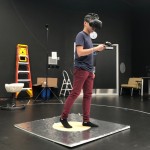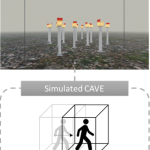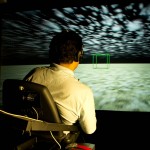Thinh (Ted) Nguyen-Vo
Biography
Thinh (Ted) has a BSc in Computer Science from HCMC University of Science. He stared an MSc at School of Interactive Arts and Technology (SIAT), Simon Fraser University in Fall 2016, and joined the iSPACE research lab, where he started his studies on VR technology and human spatial perception in immersive virtual environments. His research interests involve using technologies such as artificial intelligence, machine learning, virtual reality, augmented technology, to improve human life.
Projects
Here we propose a novel and cost-effective setup of a leaning-based interface ("NaviBoard") that allows people to efficiently navigate virtual environments - with performance levels matching the gold standard of free-space walking, without any increase in motion sickness
Abstract Walking has always been the most common locomotion mode for humans in the real world. As a result, it has also been co...
Gamifying Research - Researchifying Games
While traditional experimental paradigms offer tight stimulus control and repeatability, then tend to be a bit boring and removed from many real-world situations, which can limit real-world transferability of results.
How can we bring together the methodological strenghs of research with the intrinsic motivation of playfulness and gaming?
The ...
Would the rectangular reference frame of a CAVE help to reduce disorientation and improve navigation performance in VR? Here, we show that simply providing the rectangular reference frame of a room (as a simple wireframe cuboid), but not a CAVE improved navigational search performance.
Despite recent advances in virtual reality, locomotion in a virtual environment is still restricted becau...
How do we best design locomotion interfaces for VR that provide "enough" physical motion cues (vestibular/proprioceptive) while still being effective, affordable, compact, and safe?
Despite amazing progress in computer graphics and VR displays, most affordable and room-sized VR locomotion interfaces provide only little physical motion cues (e.g., vestibular & proprioceptive cues). To provide...
Publications
http://ispace.iat.sfu.ca/wp-content/plugins/zotpress/
37904
Nguyen-Vo, Thinh, Steve DiPaola, and Bernhard E. Riecke. 2017. “Detecting Spatial Orientation Demands during Virtual Navigation Using EEG Brain Sensing.” In
ACM SIGPLAN Workshop on Software for Augmented and Virtual Reality (SAVR 2017), 1–5. Vancouver, Canada: ACM.
https://youtu.be/-2gKhvxUGxg.
37904
Nguyen-Vo, Thinh, and Bernhard E. Riecke. 2017. “Detecting Spatial Orientation Demand during Virtual Navigation Using EEG Brain Sensing.” Poster presented at the Psychonomic Society 58th Annual Meeting, Vancouver, BC, Canada, November.
37904
Nguyen-Vo, Thinh, Bernhard E. Riecke, Wolfgang Stuerzlinger, Duc-Minh Pham, and Ernst Kruijff. 2018. “Do We Need Actual Walking in VR? Leaning with Actual Rotation Might Suffice for Efficient Locomotion.” Poster presented at the Spatial Cognition 2018.
37904
Kitson, Alexandra, Thinh Nguyen-Vo, Abraham M. Hashemian, Ekaterina R. Stepanova, and Bernhard E. Riecke. 2017. “A User Study Comparing Two Low-Cost Chair Interfaces for Embodied Virtual Locomotion.” Talk presented at the Psychonomic Society 58th Annual Meeting, Vancouver, BC, Canada, November.
37904
Nguyen-Vo, Thinh, Bernhard E. Riecke, and Wolfgang Stuerzlinger. 2017. “Investigating the Effect of Simulated Reference Frames on Spatial Orientation in Virtual Reality.” Poster presented at the Second International Workshop on Models and Representations in Spatial Cognition, Tübingen, Germany, April 6.
37904
Adhikari, Ashu, Bernhard E. Riecke, Abraham M. Hashemian, Thinh Nguyen-Vo, Ernst Kruijff, and Markus von der Heyde. 2021. “Embodied VR Flying Improves Spatial Orientation While Reducing Cybersickness.” Talk presented at the ICSC 2021: 8th International Conference on Spatial Cognition, Rome, Italy.
https://youtu.be/FbmE4SEISWU.
37904
Nguyen-Vo, Thinh, Bernhard E. Riecke, Wolfgang Stuerzlinger, Duc-Minh Pham, Ernst Kruijff, and Riecke. 2020. “NaviBoard and NaviChair: Limited Translation Combined with Full Rotation for Efficient Virtual Locomotion.” Talk presented at the IEEE Virtual Reality 2020, Atlanta, GA, USA.
https://youtu.be/JCYL2qVFO6M.
37904
Adhikari, Ashu, Abraham M. Hashemian, Thinh Nguyen-Vo, Ernst Kruijff, Markus von der Heyde, and Bernhard E. Riecke. 2021. “Lean to Fly: Leaning-Based Embodied Flying Can Improve Performance and User Experience in 3D Navigation.” Frontiers in Virtual Reality 2:1–22. https://doi.org/10.3389/frvir.2021.730334.
37904
Nguyen-Vo, Thinh, Bernhard E. Riecke, Wolfgang Stuerzlinger, Duc-Minh Pham, and Ernst Kruijff. 2019. “NaviBoard and NaviChair: Limited Translation Combined with Full Rotation for Efficient Virtual Locomotion.” IEEE Transactions on Visualization and Computer Graphics (TVCG) 27 (1): 165–77. https://doi.org/10.1109/TVCG.2019.2935730.
37904
Nguyen-Vo, Thinh, Bernhard E. Riecke, and Wolfgang Stuerzlinger. 2018. “Simulated Reference Frame: A Cost-Effective Solution to Improve Spatial Orientation in VR.” In 2018 IEEE Conference on Virtual Reality and 3D User Interfaces (VR), 415–22. Reutlingen, Germany: IEEE. https://doi.org/10.1109/VR.2018.8446383.
37904
Hashemian, Abraham M., Alexandra Kitson, Thinh Nguyen-Vo, Hrvoje Benko, Wolfgang Stuerzlinger, and Bernhard E. Riecke. 2018. “Investigating a Sparse Peripheral Display in a Head-Mounted Display for VR Locomotion.” In 2018 IEEE Conference on Virtual Reality and 3D User Interfaces (VR), 571–72. Reutlingen, Germany: IEEE. https://doi.org/10.1109/VR.2018.8446345.
37904
Nguyen-Vo, T., Riecke, B. E., & Stuerzlinger, W. (2017). Moving in a Box: Improving Spatial Orientation in Virtual Reality using Simulated Reference Frames. 207–208. https://doi.org/10.1109/3DUI.2017.7893344




